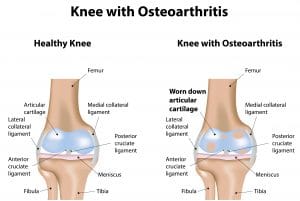
One of the most common post rehab clients I see in my practice are those who are interested in personal training after joint replacement surgery. The combination of advances in artificial implant technology and the aging population have more people seeking joint replacements, and at younger ages. These folks also expect to continue to be able to do many of the activities that they enjoy well into their golden years, such as golf, hiking, swimming, biking, and playing with their grandchildren. Considering that the complete healing process takes six months to a year, most people are discharged from physical therapy before they’ve achieved their full potential. That’s where qualified trainers like myself are available to bridge the gap with post rehab exercise.
The most common reason for joint replacement surgery is osteoarthritis, though other forms of degeneration or trauma may also be factors. At any rate, the client has typically already tried other modalities (injections, physical therapy, less invasive surgical procedures) to manage pain and has lost enough function that they finally opt for joint replacement surgery. The surgical techniques involve cutting through muscles and tendons, then removing part of the bone at the joint surface and replacing it with an artificial implant that is cemented into place. Physical therapists are the primary rehab providers immediately post-op up until 8-12 weeks after surgery depending on how the patient is progressing, with the primary goals being to restore joint range of motion and to protect any structures that were compromised and repaired as part of the surgery. Upon discharge from physical therapy, these folks are encouraged to continue with an independent exercise program, though in my experience, many aren’t sure how to progress their programs safely if they wish to continue making progress. Many of them still have some residual impairments and would benefit from the expertise of a qualified fitness professional who can help with their exercise progression. The fitness professional MUST have a clear understanding of your surgical procedure, limitations, contraindications, and other considerations before undertaking a strengthening program. Communication between the trainer and the health care provider is critical.
If you’ve had a knee replacement, hip replacement, or shoulder replacement and would like to continue progressing your strength and flexibility after discharge from physical therapy, give me a call and we can discuss your specific situation in more detail. Start today and get back to your full potential!
Want to get FREE monthly fitness and nutrition tips delivered directly to your inbox? Access to early bird discounts and opportunities before the general public? Join for FREE now!
